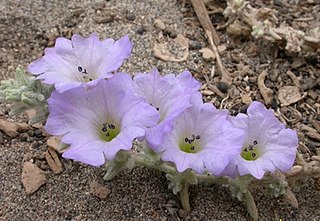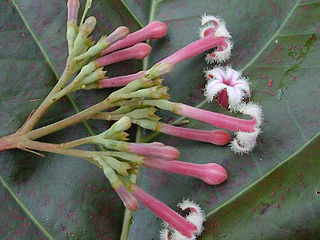
Azorella is a genus of flowering plants in the family Apiaceae, native to South America, New Zealand, southeastern Australia, and the islands of the Southern Ocean.

Calceolaria, also called lady's purse, slipper flower and pocketbook flower, or slipperwort, is a genus of plants in the family Calceolariaceae, sometimes classified in Scrophulariaceae by some authors. This genus consists of about 388 species of shrubs, lianas and herbs, and the geographical range extends from Patagonia to central Mexico, with its distribution centre in Andean region. Calceolaria species have usually yellow or orange flowers, which can have red or purple spots. The Calceolaria Herbeohybrida group, also called C. herbeohybrida Voss, is a group of ornamental hybrids known only in cultivation, called florists' slipperwort.

Baccharis is a genus of perennials and shrubs in the aster family (Asteraceae). They are commonly known as baccharises but sometimes referred to as "brooms", because many members have small thin leaves resembling the true brooms. They are not at all related to these however, but belong to an entirely different lineage of eudicots. B. halimifolia is commonly known as "groundsel bush", however true groundsels are found in the genus Senecio.

Weinmannia is a genus of trees and shrubs in the family Cunoniaceae. It contains 90 species, which range from Mexico through Central and South America including the Caribbean, and to the Mascarene Islands in the western Indian Ocean. It is absent from mainland Africa and Australia, but some fossils have been attributed to Weinmannia in Australia.

Nolana is a genus of hard annual or perennial plants in the nightshade family. The genus is mostly native to Chile and Peru. Species in this genus, especially N. paradoxa, serve as a model system for studies on flower color.

Cinchona pubescens, also known as red cinchona and quina or kina, is native to Central and South America. It is known as a medicinal plant for its bark's high quinine content- and has similar uses to C. officinalis in the production of quinine, most famously used for treatment of malaria.

Plagiobothrys is a genus of flowering plants known commonly as popcorn flowers. These are small herbaceous plants which bear tiny white or yellow flowers. Their fruits are nutlets. Although these plants are found predominantly in North America and South America, five species are known from Australia. Of the approximately 65 species described, more than 15 are endemic to California.

Munnozia is a genus of flowering plants in the family Asteraceae. It is centered in the Andes.

Mutisia is a genus of flowering plant in the tribe Mutisieae within the family Asteraceae. Mutisia has been named after José Celestino Mutis. It comprises about sixty species which can be found along the entire length of the Andes and in southern Brazil, Paraguay, Uruguay and northern Argentina.

The Mutisioideae are a subfamily in the plant family Asteraceae that includes about 630 species assigned to 44 different genera. This subfamily is mainly native in South America, except for Adenocaulon, Chaptalia, Gerbera, Trichocline, which have species in all continents other than Europe and Antarctica. Common characters are the deeply incised corollas of the disc florets, with five lobes, sometimes merged in two lips, flower heads with overlapping involucral bracts, anthers with tails and pointy tips, the styles usually stick far out of the florets and are essentially hairless. Most species are herbs, but some are vines, shrubs, or small trees.

Conanthera is a genus of small bulbous plants with small panicles of blue, purple or white and purple flowers. Propagation is by offsets or seed. All species are native to Chile, but there is an old 18th-Century report of C. bifolia occurring in colonial Peru as well. This could possibly be attributed to changes in boundaries between the two countries, as modern sources list the species as endemic to Chile.
- Conanthera bifoliaRuiz & Pav. - from Valparaíso to La Araucanía
- Conanthera campanulataLindl. - from Antofagasta to La Araucanía
- Conanthera parvula(Phil.) Muñoz-Schick - from Valparaíso to La Araucanía
- Conanthera trimaculata(D.Don) F.Meigen - central Chile
- Conanthera urceolataRavenna - Atacama

Ismene, or Peruvian daffodil, is a genus of South American plants in the Amaryllis family. The species are native to Peru and Ecuador and widely cultivated elsewhere as ornamentals because of their large, showy flowers.

Tessaria is a genus of South American plants in the tribe Inuleae within the family Asteraceae.

Hyalis is a genus of South American flowering plants in the family Asteraceae.
Mniodes is a genus of South American flowering plants in the tribe Gnaphalieae within the family Asteraceae.
Chrysactinium is a genus of South American flowering plants in the family Asteraceae.
Aphyllocladus is a genus of flowering plants in the family Asteraceae.

Columellia is a group of plant species in the Columelliaceae described as a genus in 1794.
Oriastrum is a genus of plants in the family Asteraceae, found in western South America. It is placed in the tribe Mutisieae.

The Onoserideae are a tribe of flowering plants in the family Asteraceae.














